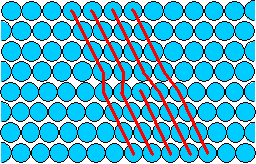Summary
In this package we have seen that a dislocation is a defect found in crystals. Dislocations are line defects, extending through a crystal for some distance along a dislocation line.
The Burgers vector specifies the magnitude and direction of the atomic movements that occur as the dislocation moves through the lattice. The angle between the line vector and Burgers vector characterises the nature of a dislocation - when the dislocation line and Burgers vector are perpendicular, the dislocation is known as an edge dislocation. When they are parallel, the dislocation is a screw dislocation. Between these two ideal angles, the dislocation is mixed.
A slice through an edge dislocation perpendicular to the dislocation line reveals that the dislocation is like an extra half-plane of atoms inserted between full planes, which are distorted to accommodate the dislocation.

A 2D schematic representation of an edge dislocation in a close-packed plane.
The bubble raft experiment shows how dislocations and other defects occur in a close-packed plane. Application of stress to the raft shows how dislocations move under an applied stress, and it can be shown that the stress required to move a dislocation is less than that required to create a similar motion via movement of whole planes of atoms simultaneously. Dislocations explain the observation of plastic deformation at lower stress than would be required in a perfect lattice, and the phenomenon of work hardening.
Dislocations can be observed by a number of methods. Only high-resolution TEM lattice images or STM surface images can show dislocations directly, but etching methods and optical microscopy can be used to elucidate the presence of dislocations, for example on sodium chloride crystal surfaces.

